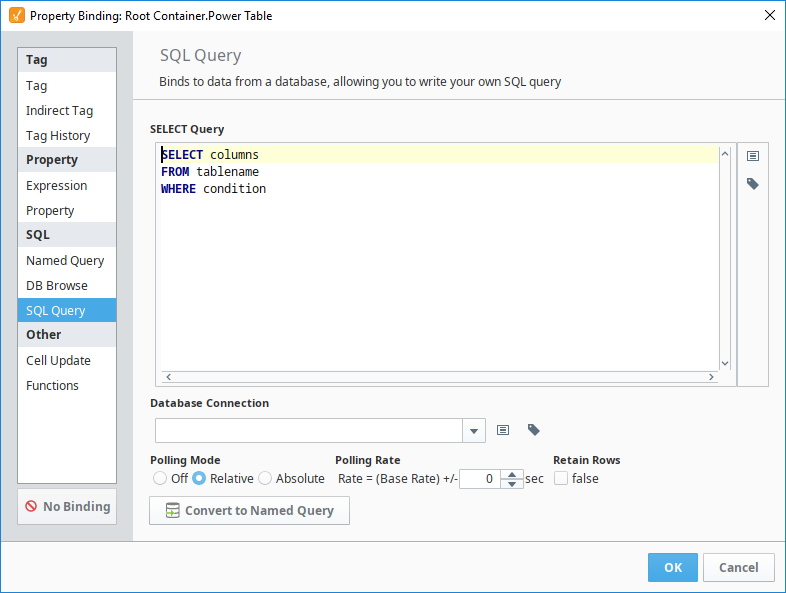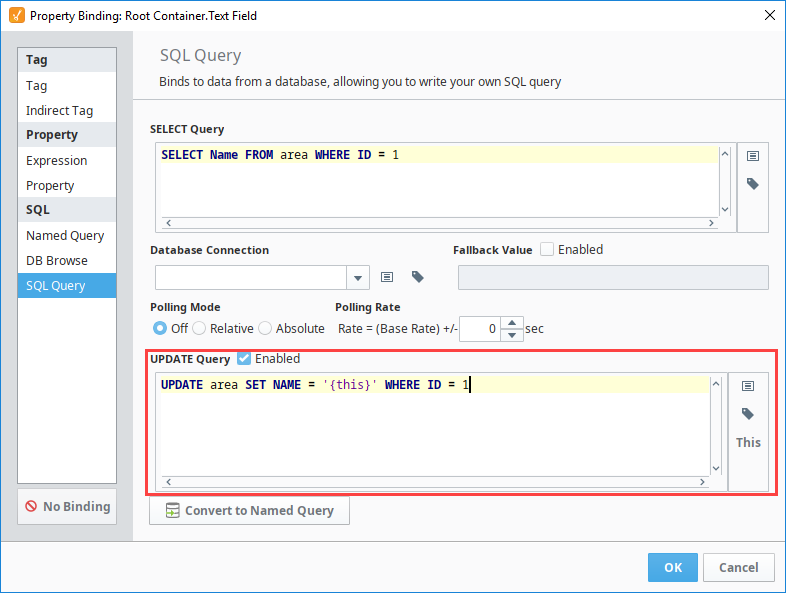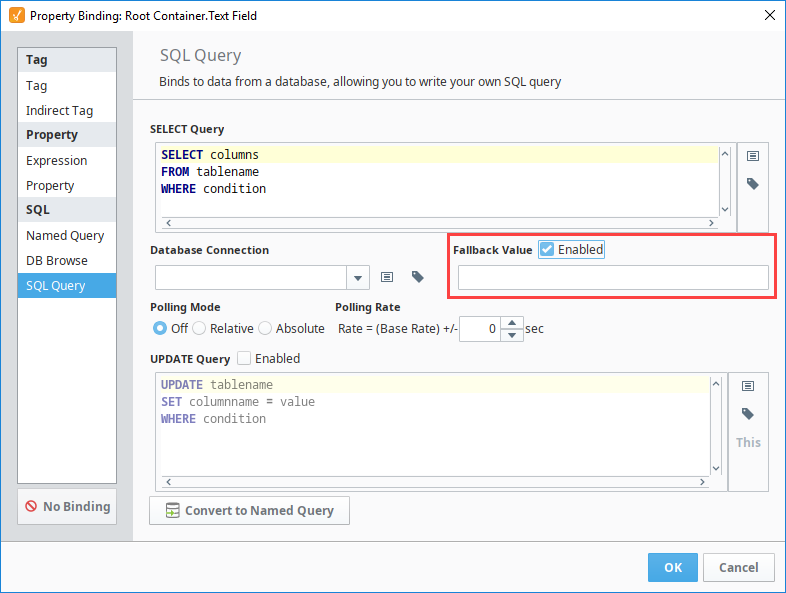SQL Query Bindings in Vision
Binding Properties to a SQL Query
The SQL Query binding is a polling binding type that will run a SQL Query against any of the database connections configured in the Gateway. It is very similar to the DB Browse binding type in that both query a database to return data. The difference is the SQL Query Binding can manually be modified. This is useful for complex queries where you will use the more advanced functions of the SQL language that can not be accomplished with the DB Browse binding.
The query that gets generated by the DB Browse will transfer over to the SQL Query binding when you switch the binding type. It may be useful to build the basic query structure with DB Browse first, then switch to SQL Query binding to modify the query to fit your needs.
Dataset Binding
The majority of SQL Query bindings will return a dataset. These will return many rows with multiple columns. For example, showing all customer details from a certain account, or all downtime events in the facility. This type of SQL binding is used on properties of type dataset like the Data property on a Table component.

Dynamic Filters
Using the curly brace {} notation, you can include the values of component properties (within the same window) and Tag values inside your query. This is a very common technique to make your query dynamic. The values of the property or Tag represented are simply substituted into the query where the braces are.
Because the substitution is direct, you'll often need to add quotes to literal strings and dates to make your query valid. If you're getting errors running your query complaining about syntax, it is important to realize that these errors are coming from the database, not from Ignition. Try copying and pasting your query into the Query Browser and replacing the braces with literal values.
Example
A common requirement is to have a query filter its results for a date range. You can use the Date Range component or a pair of Popup Calendar components to let the user choose a range of dates. Then you can use these dates in your query like this:
SELECT
t_stamp, flow_rate, amps
FROM
valve_history
WHERE
t_stamp >= '{Root Container.DateRange.startDate}' AND
t_stamp <= '{Root Container.DateRange.endDate}'
Notice the single quotes around the braces. This is because when the query is run, the dates will be replaced with their literal evaluations. For example, the actual query sent to the database might look like this:
SELECT
t_stamp, flow_rate, amps
FROM
valve_history
WHERE
t_stamp >= '2010-03-20 08:00:00' AND
t_stamp <= '2010-03-20 13:00:00'
It is important to use single quotes and not double quotes (t_stamp = "2010-03-20 08:00:00") because these mean something different in certain databases like Microsoft SQL Server.
Scalar Query Update
You can bind a non dataset type property to a SQL query to allow a singular value to be returned from the database with a scalar query. Now instead of returning multiple rows and columns, the query returns a single value from the first row of the first column. These types of SQL Query bindings can also be used to update the database on input components like a Text Field. Essentially, we mimic the bidirectionality of Tag and property bindings by adding in an update query to run whenever a value gets entered into the property with the binding. In our update query, we use the special parameter {this} to denote the new value from the bound property. If {this} is a string, it needs single quotes around it.

Take a Text Field with a simple query on it.
SELECT Name FROM area WHERE ID = 1
This will return a single value that can populate our text field. We then enable the Update Query at the bottom of the Property Binding window, and add in the update query.
UPDATE area SET Name = '{this}' WHERE ID = 1
After confirming the binding, we can see that our text field contains the value from the database and will update the database cell if we enter in a new value into the text field. This is a good way to alter very specific cells in a database table.
Scalar Query Fallback
If the property that is being bound is a scalar datatype (that is, not a Dataset), the value in the first column in the first row of the query results is used. If no rows were returned, the binding will cause an error unless the Use Fallback Value option is selected. The value entered in the fallback value text box will be used when the query returns no rows.
When binding a Dataset to a SQL Query, no fallback value is needed, because a Dataset will contain zero rows.

Stored Procedures
While queries can manually be written on a SQL Query binding, SQL Stored Procedures may also be called from a SQL Query Binding. Note, that the exact syntax is highly dependent on the type of database you are using.
For example, calling a Stored Procedure from MySQL would involve using the CALL command, while SQL Server utilizes the EXEC command.
CALL retrieve_daily_total
EXEC retrieve_daily_total
Named Query Conversions
You can convert the SQL Query created here to a Named Query. For more information, see Named Query Conversions.
